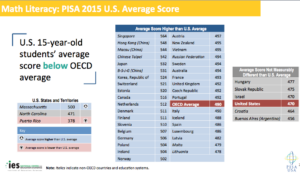 Credit: Mediaphotos/iStock
Credit: Mediaphotos/iStock Credit: Mediaphotos/iStock
Credit: Mediaphotos/iStockU.S. students declined in average math scores in the latest round of international testing, ranking below 36 countries or educational systems out of more than 70 that participated.
U.S. students showed no signs of improvement in science and reading.
According to results released Tuesday, the top-performing country in all three subjects was Singapore.
Others that outscored U.S. students in math and beat the international average include Hong Kong, parts of China, the Republic of Korea, Switzerland, Estonia, Canada, the Netherlands, Denmark, Finland, Slovenia, Belgium, Germany, Poland, Ireland, Norway, Austria, New Zealand, Vietnam, the Russian Federation, Sweden, Australia, France, the United Kingdom, Czech Republic and Portugal.

U.S. 15-year-olds scored below the national average in math on the PISA test in 2015.
Fifteen–year–olds in 73 countries or education systems participated in the Program for International Student Assessment, or PISA testing, coordinated by the Organization for Economic Cooperation and Development, or OECD, an international governmental agency that includes 35 mostly developed member countries.
In the United States, the testing is conducted by the National Center for Education Statistics, or NCES.
“Mathematics remains the subject that the U.S. fares worst in, comparatively, and our students continue to score below the average for OECD member nations,” said Peggy G. Carr, acting commissioner of the National Center for Education Statistics, which released the results. “Of particular concern is that we also have a higher percentage of students who score in the lowest performance levels, compared to the OECD average, and a lower percentage of top math performers.”
The U.S. average score in math was 470 out of 1,000, 20 points below the international average of 490 and 12 points lower than the U.S. average in 2012, the last time the test was given. Still, U.S. average scores surpassed those in 28 education systems and were similar to five.
Only 6 percent of U.S. students scored at the highest levels on the math tests, which was lower than the international average of 11 percent.
At the other end of the spectrum, 29 percent of U.S. students scored below the PISA proficiency level, which was higher than the international average of 23 percent.
“We’re losing ground – a troubling prospect when, in today’s knowledge-based economy, the best jobs can go anywhere in the world,” said U.S. Education Secretary John King Jr. “Students in Massachusetts, Maryland and Minnesota aren’t just vying for great jobs along with their neighbors or across state lines, they must be competitive with peers in Finland, Germany and Japan.”
Jeanne Allen, founder and CEO of the Center for Education Reform, said the results call for action.
“This is a rallying cry for anyone concerned about this country, and evidence once again that we must put opportunity and innovation on the front end of all education policy initiatives,” she said. “The lagging indicators of U.S. education will be a critical challenge for the new Administration.”
One of the issues just may become the Common Core standards, which President-elect Donald Trump has called a “total disaster” and has vowed to kill. However, the Every Student Succeeds Act, or ESSA, gives states control over their own standards and prevents the federal government from dictating what should or should not be taught.
Can Common Core help U.S. students?
Andreas Schleicher, the OECD’s director for education and skills, in response to a question from EdSource Monday said that it’s too early to judge whether new Common Core math and English language arts standards adopted in most states have made a difference in test scores.
“The Common Core concept is quite well-aligned with what we see in many high-performing systems, so I would give it a chance,” he said, calling it “probably one of the greatest promises” for improvement.
Muhammed Chaudhry, president and CEO of the Silicon Valley Education Foundation, said he believes schools across the country need to “stay the course” in implementing Common Core standards in math and English language arts for U.S. students to compete globally. He said the results do not accurately reflect the impact of the new, more rigorous standards since they are still not fully implemented.
“It’s going to take time for us to come up to speed,” he said, adding that Next Generation Science Standards are also being implemented in some states such as California, but have not been adopted in all states across the country.
In the short run, he said, companies in Silicon Valley must recruit workers from outside the United States. In the long run, he said, more than 1 million computer science jobs will need to be filled with workers who have strong science and math skills. He said states like California need to invest more money in math and science education, along with teacher training.
“Professional development needs to be much more robust if we want to win the war on talent,” he said.
Jon Star, a Harvard education professor, said he thinks most high school math educators across the country have not changed their teaching practices according to the Common Core in the same way that elementary teachers have done, such as by leading discussions about math and facilitating group projects.
“We need to think about how to nudge high school teachers in that direction,” he said. “At high school, these major changes are beyond the capacity for change for most teachers.”
He suggested that high school teachers should strive to ask better questions, wait longer for students to come up with answers, think about project-based problems that would challenge their students more, and be more reflective about their teaching practice.
The U.S. reading score was 497 – about the same as the international average of 493 and lower than 14 educational systems, higher than 42, and comparable to 13. The score remained stagnant compared to all other test administrations every three years since 2000.
In science, the U.S. average score was 496 – or comparable to the international average of 493. This was lower than average scores in 18 educational systems, higher than 39, and about the same as 12. These scores have remained stagnant since 2006.
King found two “bright spots” among the lackluster results – the U.S. narrowed its achievement gap between low-income students and their higher-income peers, and the state of Massachusetts, which was one of two to receive individual results on the exams, surpassed the U.S. average and international averages.
California did not receive statewide results because the state did not have enough students taking the test to get its own results. Massachusetts, North Carolina and Puerto Rico got their own reports.
“Data show that the relationship between poverty and student achievement has declined in recent years, at least in science, with students’ socioeconomic status becoming a less reliable predictor of performance,” King said. “Socioeconomic status accounted for 11 percent of the variation in student performance in 2015 – down 6 percentage points from 2006. And the U.S. has made more progress in closing the socioeconomic achievement gap than any other PISA country.”
Randi Weingarten, president of the American Federation of Teachers, called the results “disappointing, but not surprising.” She predicted ESSA will strengthen public education “by increasing equity for disadvantaged children, providing more state and local control, and holding charters more accountable.”
Countries like Germany, Canada, Hong Kong and Estonia use tests to determine what a student needs to learn instead of for punishment, and respect teachers’ “professional knowledge and judgment,” she said, adding that Finland has slipped in the rankings since its government has decreased education funding and moved away from “student- and teacher-centered strategies.”
King also stressed the importance of ESSA going forward, along with teacher quality.
“ESSA creates an opportunity for states and schools to reclaim the promise of a high-quality, well-rounded education for all students and ensure that every child is held to high, college- and career-ready standards,” he said. “But no law, no policy, no amount of money, not even the weight of good intentions can make a difference without the hard and skillful work of educators.”
This was the second international test of students released this month. Last week, the NCES released results from the 2015 Trends In International Mathematics and Science Study, or TIMSS, tests administered in math and science to 4th-graders and 8th-graders, as well as an advanced test for 12th-graders. Those results showed 8th-graders made progress in math, while fourth-graders’ scores remained flat.
The complete PISA report is at http://nces.ed.gov/surveys/pisa/.
This story was updated on Dec. 6 with a quote from Jeanne Allen, founder and CEO of the Center for Education Reform and President-elect Donald Trump’s position on Common Core standards.
To get more reports like this one, click here to sign up for EdSource’s no-cost daily email on latest developments in education.


Comments (6)
Comments Policy
We welcome your comments. All comments are moderated for civility, relevance and other considerations. Click here for EdSource's Comments Policy.
Teresa 5 years ago5 years ago
As a parent of 2 recent public school graduates, I witnessed first hand the increasing frustration both of my students developed toward math. In our district, the trend has been to employ math teaching apps rather than the skills of a dedicated teacher. Some if the reasons given were that this is what colleges use and that teachers did not want to be burdened with grading papers. Since the teacher is no longer engaged in … Read More
As a parent of 2 recent public school graduates, I witnessed first hand the increasing frustration both of my students developed toward math. In our district, the trend has been to employ math teaching apps rather than the skills of a dedicated teacher. Some if the reasons given were that this is what colleges use and that teachers did not want to be burdened with grading papers. Since the teacher is no longer engaged in the grading process, the student does not receive the invaluable feedback needed to grow. What my kids told me was that classmates use apps designed specifically to cheat. Just take a photo and an answer is provided. Other apps can provide the entire problem worked out. While some kids want to be taught, others want to steal points.
Districts or individuals trying to gain recognition in the age of the digital promise, have made a terrible mistake in choosing technology over teaching. Technology should only supplement teaching as an occasionall blended assignment.
My sister has been a math teacher her entire professional life. Her district allows no technology in the math classroom. Her team meets regularly to share and remain vigilant about math cheating apps. She grades papers every night. Recently both the valedictorian and salutorian in the graduating class in her district requested her to hand them their diplomas. There is no substitute for a good teacher who values the profession of teaching. You do the math.
Daniel Phu 6 years ago6 years ago
Math is very easy for most of kids if we can bring math to their understanding level and make math so easy that they would want to learn from us again and again. My older son reached advanced engineering level at 10 and my daughter at 7 years old because I taught her calculus at 5, a little earlier than her brother. The earlier I teach math to them, the better they adopt math … Read More
Math is very easy for most of kids if we can bring math to their understanding level and make math so easy that they would want to learn from us again and again. My older son reached advanced engineering level at 10 and my daughter at 7 years old because I taught her calculus at 5, a little earlier than her brother.
The earlier I teach math to them, the better they adopt math as part of themselves. Therefore, I started to teach my third kid at 2 and he too can solve basic algebra equations with small number at 3 year old. Now, My 1 year old kid already knows how to count figure 1 to 10. and adds 1 to them. I know they will know math from algebra, to calculus and some advanced engineering mathematics at 5 year old this time.
I can conclude that if we teach them early and teach them systematically right. We are not only make them smart but also shift their learning curve to extreme potential.
It is hard to believe kids can learn that much and that early until you see “Kid calculus, kid proofs calculus formulas, or Kid doing advanced engineering mathematics” from YouTube, then you will believe the powerful result of early learning math. It is real, and it is possible. For this reason, I have documented and posted so people can see, as well as researchers who will know that kids can learn at much earlier than we think they can.
Kelly Ferreira 6 years ago6 years ago
Of course these scores reflect the failure of Common Core Standards – students have been doing Common Core for over three years in my school district. Public schools' aim is to make all kids equal, regardless of talent. Therefore, it is considered a success to see the "achievement gap" closing even though kids are losing academic ground. Stop teaching emotional learning, computer apps, group learning, standardized tests, and all the other nonsense. … Read More
Of course these scores reflect the failure of Common Core Standards – students have been doing Common Core for over three years in my school district. Public schools’ aim is to make all kids equal, regardless of talent. Therefore, it is considered a success to see the “achievement gap” closing even though kids are losing academic ground.
Stop teaching emotional learning, computer apps, group learning, standardized tests, and all the other nonsense. Start teaching academics and hold individuals accountable, even if that means they have to retake a class or an entire year. Furthermore, hire only the most qualified teachers. Make teachers take academic tests in the subjects they will teach, and get rid of unions, which will motivate teachers to keep high standards. Better yet, find a great private school!
Sylvie Gaudet 6 years ago6 years ago
BS Common Core is a failure. Please go back the way math was thought back in the 80´s. Enough pressure on the kids. Stop comparing yourselves to other countries people in the Common Core Business. Kids can’t be kids anymore they have barely no time to play because of this nonsense.
Wayne Bishop 6 years ago6 years ago
The Common Core-Math (as interpreted nationwide) and the NGSS are professional education mistaken goals that do not comport with genuine readiness in mathematics or science at a level that means anything to the nation; i.e., preparedness for real STEM careers that require solid mathematics and real science at the level of traditional textbook competence. Ironically, PISA is a horrible test of those competencies (TIMSS is greatly superior and our focus should be on performance … Read More
The Common Core-Math (as interpreted nationwide) and the NGSS are professional education mistaken goals that do not comport with genuine readiness in mathematics or science at a level that means anything to the nation; i.e., preparedness for real STEM careers that require solid mathematics and real science at the level of traditional textbook competence. Ironically, PISA is a horrible test of those competencies (TIMSS is greatly superior and our focus should be on performance there, considerably better than PISA, but not nearly good enough).
Professor of Mathematics, Emeritus
Jonathan Crabtree 6 years ago6 years ago
PISA MATH RANK REASON?
I spoke at a math conference last week and revealed how a London haberdasher changed (the great) Euclid’s definition of multiplication. Amazingly, nobody picked up the blunder!
So the English language definition of multiplication hasn’t worked since 1570! China, France and America (early on) fixed the stuff-up.
It’s all in the article at http://bit.ly/LostLogicOfMath
Jonathan Crabtree
Math Historian